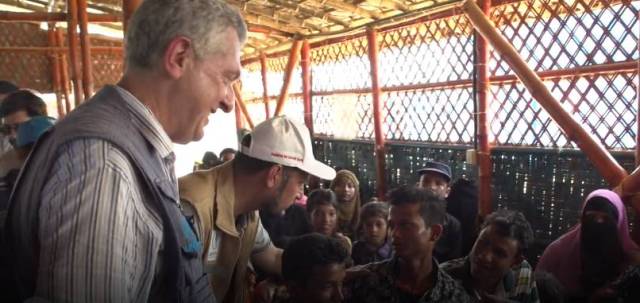 UN and IOM officials Mark Lowcock, António Vitorino and Filippo Grandi visit a Rohingya refugee camp in April 2019. [photo: courtesy of UNHCR Refugees Media]
UN and IOM officials Mark Lowcock, António Vitorino and Filippo Grandi visit a Rohingya refugee camp in April 2019. [photo: courtesy of UNHCR Refugees Media]
[This is the introduction from an article which appears in the latest edition of The Round Table: The Commonwealth Journal of International Affairs.]
The politics of refugee repatriation are often complicated and can aggravate already volatile security concerns. Since 2005 the number of refugees worldwide has over doubled and this augmentation has posed daunting challenges for the United Nations High Commissioner for Refugees (UNHCR) and the international community at large. In 2017, of the more than 68 million forcibly displaced persons, nearly 26 million were categorised as refugees; and while the UNHCR has improved in its ability to confront challenges associated with returning refugees, the toolkit for successful repatriation is far from perfect.
Repatriation is increasingly complex when considering stateless refugees. Although often used interchangeably, refugees and stateless persons are two distinct classifications each with their own UN convention outlining their respective rights and protections. The year 1951 saw the adoption of the Convention and Protocol Relating to the Status of Refugees while 1954 ushered in the Convention Relating to the Status of Stateless Persons Convention and Protocol Relating to the Status of Refugees. Generally, their protections read similarly, but while refugees lack protection from their country of origin, stateless persons lack the very essence of citizenship – ‘the right to have rights’ and the basic recognition and rights afforded to a state’s citizens. Unsurprisingly, stateless persons are often designated as one of the world’s most vulnerable populations and attempts at repatriating stateless refugees are often met with barriers from multiple states.
Estimates in 2017 identified approximately 10 million people as stateless with upwards of 1.5 million considered stateless refugees; that is, stateless persons who fled their self-identified country of origin in search of asylum. The estimates of stateless refugees are for the year 2016.View all notes To put these numbers in context, nearly two-thirds of the 1.5 million were stateless refugees from Myanmar residing in Bangladesh, virtually all self-identifying as Rohingya . The December 2017 figure was 932,204. Given the number of stateless refugees in Bangladesh and growing concerns over the country’s ability to accommodate such a large population, questions have continued to arise about their repatriation. This is particularly relevant given concerns over the looming monsoon season which the UN has estimated will have an impact on upwards of 200,000 Rohingya residing in Bangladesh. Monsoon season threatens Rohingya refugees in Bangladesh. Unsurprisingly, this has been a complicated endeavour given that the Rohingya, although having lived in Myanmar for generations, are not deemed citizens and lack many rights, opportunities and protections, including restrictions on movement within the country, the inability for more than four people to gather together in one place, and segregation policies which have limited their access to a variety of services including government education. Further, their historical persecution within Myanmar and concerns about their treatment should they return to the Rakhine State are ambiguous at best.
The purpose of this paper is twofold. It first aims to define and clarify ambiguities surrounding stateless refugees. Second, our analysis explores how statelessness can motivate refugees to stay or go during a repatriation process and how the condition of statelessness hinders a sustainable refugee repatriation processes. From here, the paper proceeds as follows. First, we briefly examine the literature on factors contributing to the success or failure of repatriation efforts. In particular, we examine the principle of ‘statelessness’, offering a discussion of international legal ramifications resulting from the designation. We introduce our central argument, which identifies a population’s designation as stateless as a key inhibitor to the success of repatriation. We probe our argument qualitatively using an in-depth examination of the repatriation of the Rohingya in the1990s, highlighting how these efforts parallel the ongoing crisis. We then assess the illustrative case of a (largely) successful repatriation of the past – the Angolan refugee repatriation of 2002–2005. Though markedly different, the Angolan case underscores the importance of refugees’ status before and during repatriation. We conclude with a brief discussion of implications for future repatriation efforts and broader regional security issues in Southeast Asia.
Christopher Faulkner & Samuel Schiffer are with the Department of Political Science, University of Central Florida, Orlando, Florida.



